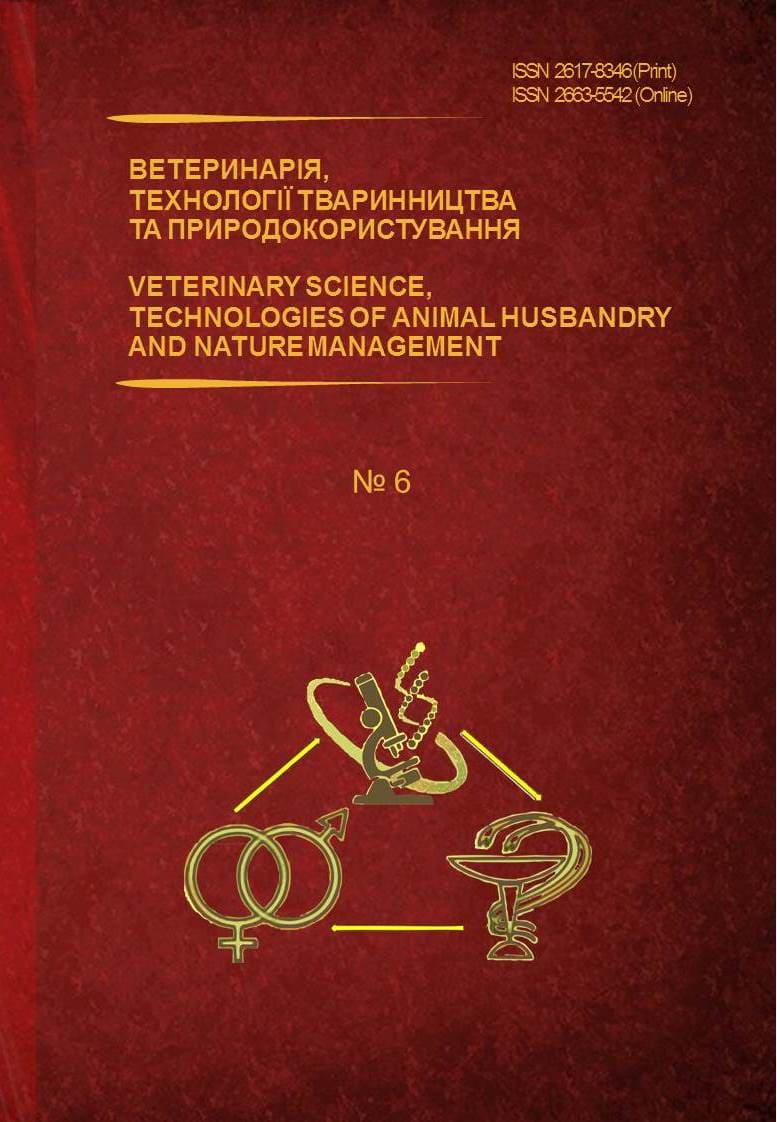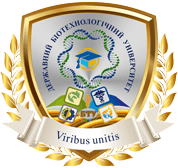Особливості мікроскопічної будови сліпих кишок качок
Анотація
Метою роботи було визначити особливості мікроскопічної будови сліпих кишок качок упродовж першого року постнатального періоду онтогенезу. Загальною закономірністю змін морфометричних показників мікроструктур сліпих кишок качок було їх збільшення, яке носило асинхронний характер. Значенням дорослої птиці параметри сліпих кишок качок відповідали в різному віці: в 1-річному – діаметр кишки, товщина серозної оболонки, щільність ворсинок, глибина крипт; у 6-місячному – ширина ворсинок; в 1-місячному – товщина стінки кишки, її слизової оболонки, щільність ворсинок, площа їх поверхні, висота епітелію крипт; в 21-добовому – висота ворсинок і їх епітелію, товщина м’язової оболонки і м’язової пластинки; у 3-добовому віці – ширина і щільність крипт. Найбільш інтенсивно такі зміни відбувались у перший місяць постнатального періоду онтогенезу, упродовж якого найбільш швидко вони змінювались у перший тиждень.
Завантаження
Посилання
Ali, A. А. M., Mokhtar, D. M., Ali, R. A., Wassif, E. T., & Abdalla, K. E. H. (2019). Morphological characteristics of the developing cecum of Japanese quail (Coturnix coturnix japonica). Microscopy and Microanalysis, 25(4), 1017-1031. DOI: 10.1017/S1431927619000655.
Ao, X., & Kim, H. (2020). Effects of grape seed extract on performance, immunity, antioxidant capacity, and meat quality in Pekin ducks. Poultry Science, 99(4), 2078-2086. DOI: 10.1016/j.psj.2019.12.014.
Casteleyn, C., Doom, M., Lambrechts, E., Van den Broeck, W., Simoens, P., & Cornillie, P. (2010). Locations of gut-associated lymphoid tissue in the 3-month-old chicken: a review. Avian Pathology, 39(3), 143-150. DOI: 10.1080/03079451003786105.
Chaplin, S. B. (1989). Effect of cecectomy on water and nutrient absorption of birds. Journal of Experimental Zoology, 3, 81-86. DOI: 10.1002/jez.1402520514.
Chen, W. L., Tang, S. G. H., Jahromi, M. F., Candyrine, S. C. L., Idrus, Z., Abdullah, N., & Liang, J. B. (2019). Metagenomics analysis reveals significant modulation of cecal microbiota of broilers fed palm kernel expeller diets. Poultry Science, 98(1), 56-68. DOI: 10.3382/ps/pey366.
Choi, J. H., Lee, K., Kim, D. W., Kil, D. Y., Kim, G. B., & Cha, C. J. (2018). Influence of dietary avilamycin on ileal and cecal microbiota in broiler chickens. Poultry Science, 97(3), 970-979. DOI: 10.3382/ps/pex360.
Cutrignelli, M. I., Messina, M., Tulli, F., Randazzo, B., Olivotto, I., Gasco, L., Loponte, R., & Bovera, F. (2018). Evaluation of an insect meal of the Black Soldier Fly (Hermetia illucens) as soybean substitute: Intestinal morphometry, enzymatic and microbial activity in laying hens. Research in Veterinary Science, 117, 209-215. DOI: 10.1016/j.rvsc.2017.12.020.
Duke, G. E. (1989). Relationship of cecal and colonic motility to diet, habitat, and cecal anatomy in several avian species. Journal of Experimental Zoology, 3, 38-47. DOI: 10.1002/jez.1402520507.
Gabriel, I., & Mallet, S. (2003). Differences in the digestive tract characteristics of broiler chickens fed on complete pelleted diet or on whole wheat added to pelleted protein concentrate. British Poultry Science, 44(2), 283-290. DOI: 10.1080/0007166031000096470.
Goldstein, D. L. (1989). Absorption by the cecum of wild birds: is there interspecific variation. Journal of Experimental Zoology, 3, 103-10. DOI: 10.1002/jez.1402520517.
Hamid, H., Zhang, J. Y., Li, W. X., Liu, C., Li, M. L., Zhao, L. H., Ji, C., & Ma, Q. G. (2019). Interactions between the cecal microbiota and non-alcoholic steatohepatitis using laying hens as the model. Poultry Science, 98(6), 2509-2521. DOI: 10.3382/ps/pey596.
He, J., He, Y., Pan, D., Cao, J., Sun, Y., & Zeng, X. (2019). Associations of gut microbiota with heat stress-induced changes of growth, fat deposition, intestinal morphology, and antioxidant capacity in ducks. Frontiers in Microbiology, 10, 903. DOI: 10.3389/fmicb.2019.00903.
He, L. W., Meng, Q. X., Li, D. Y., Zhang, Y. W., & Ren, L. P. (2015). Influence of feeding alternative fiber sources on the gastrointestinal fermentation, digestive enzyme activities and mucosa morphology of grow wing Graylag geese. Poultry Science, 94(10), 2464-2471. DOI: 10.3382/ps/pev237.
Hunt, A., Al-Nakkash, L., Lee, A. H., & Smith, H. F. (2019). Phylogeny and herbivore are related to avian cecal size. Scientific Reports, 9(1), 4243. DOI: 10.1038/s41598-019-40822-0.
Jacquier, V., Nelson, A., Jlali, M., Rhayat, L., Brinch, K. S., & Devillard, E. (2019). Bacillus subtilis 29784 induces a shift in broiler gut microbiome toward butyrate-producing bacteria and improves intestinal histomorphology and animal performance. Poultry Science, 98(6), 2548-2554. DOI: 10.3382/ps/pey602.
Jozefiak, D., Rutkowski, A., Kaczmarek, S., Jensen, B. B., Engberg, R. M., & Højberg, O. (2010). Effect of β-glucanase and xylanase supplementation of barley- and rye-based diets on caecal microbiota of broiler-chickens. British Poultry Science, 51(4), 546-57. DOI: 10.1080/00071668.2010.507243.
Karasawa, Y. (1989). Ammonia production from uric acid, urea, and amino acids and its absorption from the ceca of the cockerel. The Journal of Experimental Zoology, 3, 75-80. DOI: 10.1080/00071668808417033.
Mandal, R. S., Saha, S., & Das, S. (2015). Metagenomic surveys of gut microbiota. Genomics Proteomics Bioinformatics, 13(3), 148-158. DOI: 10.1016/j.gpb.2015.02.005.
McLelland, J. (1989). Anatomy of the avian cecum. Journal of Experimental Zoology, 3, 2-9. DOI: 10.1002/jez.1402520503.
Mitjans, M. G., Barniol, G., & Ferrer, R. (1997). Mucosal surface area in chicken small intestine during development. Cell and Tissue Research, 290, 71-78. DOI: 10.1007/s004410050909.
Moran, E. T. (1985). Digestion and absorption of carbohydrates in fowl and events through perinatal development. Journal of Nutrition, 115, 665-674. DOI: 10.1093/jn/115.5.665.
Moss, R. (1989). Gut size and the digestion of fibrous diets by tetraonid birds. Journal of Experimental Zoology, 3, 61-65. DOI: 10.1002/jez.1402520510.
Noy, Y., & Sklan, D. (1997). Posthatch development in poultry. Journal of Applied Poultry, 6(3), 344–354. DOI: 10.1093/japr/6.3.344.
Noy, Y., Geyra, A., & Sklan, D. (2001). The effect of early feeding on growth and small intestinal development in the posthatch poultry. Poultry Science, 80, 912-919. DOI: 10.1093/ps/80.7.912.
Oakley, B. B., Buhr, R. J., Ritz, C. W., Kiepper, B. H., Berrang, M. E., Seal, B. S., & Cox, N. A. (2014). Successional changes in the chicken cecal microbiome during 42 days of growth are independent of organic acid feed additives. BMC Veterinary Research, 10, 282. DOI: 10.1186/s12917-014-0282-8.
Pandit, K., Dhote, B. S., Mahanta, D., Sathapathy, S., Tamilselvan, S., Mrigesh, M., & Mishra, S. (2018). Histological, histomorphometrical and histochemical studies on the large intestine of Uttara fowl. International Journal of Current Microbiology and Applied Sciences, 7(3), 1477-1491. DOI: 10.20546/ijcmas.2018.703.176.
Remington, T. E. (1989). Why do grouse have ceca? A test of the fiber digestion theory. Journal of Experimental Zoology, 3, 87-94. DOI: 10.1002/jez.1402520515.
Rodjan, P., Soisuwan, K., Thongprajukaew, K., Theapparat, Y., Khongthong, S., Jeenkeawpieam, J., & Salaeharae, T. (2018). Effect of organic acids or probiotics alone or in combination on growth performance, nutrient digestibility, enzyme activities, intestinal morphology and gut microflora in broilerchickens. Journal of Animal Physiology and Animal Nutrition (Berl), 102(2), e931-e940. DOI: 10.1111/jpn.12858.
Sell, J. L., Angel, C. R., Piquer, F. J., Mallarino, E. G., & Al-Batshan, H. A. (1991). Developmental patterns of selected characteristics of the gastrointestinal tract of young turkeys. Poultry Science, 70, 1200–1205. DOI: 10.3382/ps.0701200.
Sklan, D. (2001). Development of the digestive tract of poultry. British Poultry Science, 57, 415-428. DOI: 10.1079/WPS20010030.
Stanley, D., Geier, M. S., Chen, H., Hughes, R. J., & Moore, R. J. (2015). Comparison of fecal and cecal microbiotas reveals qualitative similarities but quantitative differences. BMC Microbiology, 27, 15-51. DOI: 10.1186/s12866-015-0388-6.
Svihus, B., Choct, M., & Classen, H. L. (2013). Function and nutritional roles of the avian caeca: a review. Worlds Poultry Science, 69, 249–264. DOI: 10.1017/S0043933913000287.
Trifonov, G. A., & Kuleshov, K. A. (2008). Postnatalnyiy morfogenez dvenadtsatiperstnoy kishki kur pri primenenii selensoderzhaschih preparatov. Vestnik Altayskogo gosudarstvennogo agrarnogo universiteta, 3 (41), 33–36. (in Russian)
Turk, D. E. (1982). The anatomy of the avian digestive tract as related to feed utilization. Poultry Science, 61, 1225-1244. DOI: 10.3382/ps.0611225.
Uni, Z., Noy, Y., & Sklan, D. (1999). Post hatch development of small intestinal function in the poultry. Poultry Science, 78, 215-222. DOI: 10.1093/ps/78.2.215.
van Staaveren, N., Krumma, J., Forsythe, P., Kjaer, J. B., Kwon, I. Y., Mao, Y. K., West, C., Kunze, W., & Harlander-Matauschek, A. (2020). Cecal motility and the impact of Lactobacillus in feather pecking laying hens. Scientific Reports, 10(1), 12978. DOI: 10.1038/s41598-020-69928-6.
Walton, K. D., Kolterud, A., Czerwinski, M. J., Bell, M. J., Prakash, A., Kushwaha, J., Grosse, A. S., Schnell, S., & Gumucio, D. L. (2012). Hedgehog-responsive mesenchymal clusters direct patterning and emergence of intestinal villi. Proceedings National Academy of Sciences of the United States of America, 109(39), 15817-15822. DOI: 10.1073/pnas.1205669109.
Wang, J. X., & Peng, K. M. (2008). Developmental morphology of the small intestine of African ostrich chicks. Poultry Science, 87, 2629-2635. DOI: 10.3382/ps.2014-04091.
Wang, S., Chen, L., He, M., Shen, J., Li, G., Tao, Z., Wu, R., & Lu, L. (2018). Different rearing conditions alter gut microbiota composition and host physiology in Shaoxing ducks. Scientific Reports, 8(1), 7387. DOI: 10.1038/s41598-018-25760-7.
Xing, Y., Wang, S., Fan, J., Oso, A. O., Kim, S. W., Xiao, D., Yang, T., Liu, G., Jiang, G., Li, Z., Li, L., & Zhang, B. (2015). Effects of dietary supplementation with lysine-yielding Bacillus subtilis on gut morphology, cecal microflora, and intestinal immune response of Linwu ducks. Journal of Animal Science, 93(7), 3449-57. DOI: 10.2527/jas.2014-8090.
Xue, G. D., Barekatain, R., Wu, S. B., Choct, M., & Swick, R. A. (2018). Dietary L-glutamine supplementation improves growth performance, gut morphology, and serum biochemical indices of broiler chickens during necrotic enteritis challenge. Poultry Science, 97(4), 1334-1341. DOI: 10.3382/ps/pex444.
Yan, W., Sun, C., Yuan, J., & Yang, N. (2017). Gut metagenomic analysis reveals prominent roles of Lactobacillus and cecal microbiota in chicken feed efficiency. Scientific Reports, 7(45308). DOI: 10.1038/srep45308.
Yovchev, D., Dimitrov, D., & Penchev, G. (2013). Age weight and morphometrical parameters of the bronze turkey’s (Meleagris meleagris gallopavo) intestines. Bulgarian Journal of Agricultural Science, 19(3), 611-614.
Переглядів анотації: 976 Завантажень PDF: 607





